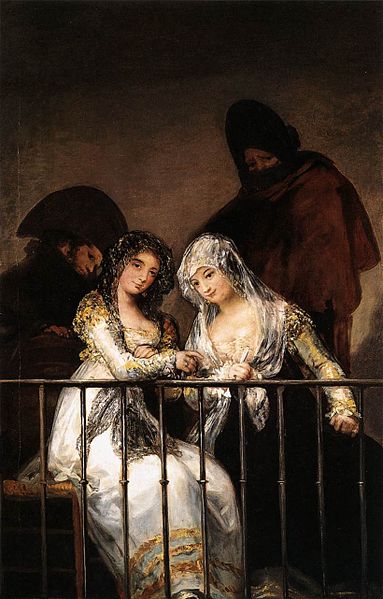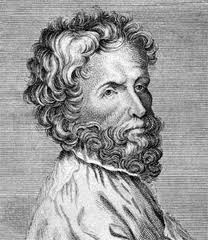July 22, 2013.Enrique Granados and Cristóbal de Morales.Enrique Granados, one of the most important Spanish composer’s of the new era, was born on July 27, 1867 in Lérida, Catalonia.We wrote, rather extensively, about Granados a year ago, so to celebrate his birthday we’ll present a couple of pieces that were uploaded since then.Both come from Goyescas, Op. 11, a suite inspired by the painting of Francisco Goya and probably Granados’s most significant (and difficult) composition.First, El amor y la muerte (Balada) or Ballad of Love and Death, the fifth piece of the suite.It is performed by Ruti Abramovitch (here).El pelele (The Straw Man) was written in 1914, later than the original six pieces of Goyescas. Granados gave it a subtitle Escena goyesca and it’s usually performed as part of the suite.Here it is played by the Spanish pianist Carlos Gallardo.
Cristóbal de Morales was at least as important to the development of the Spanish Renaissance music as Granados was to the modern era.Morales was born in Seville around 1500.He was trained as a choirboy in the magnificent (and then just completed) Cathedral of the city.Around 1526 he became the choirmaster at the Cathedral of Ávila, and later, from 1529 to 1532, held the same position in Plasencia.Apparently, he was an outstanding singer.At least since the Spanish Pope Alexander VI (born Rodrigo Borgia), Rome was partial to Spanish singers, and in 1535 the Pope Paul III made sure that Morales was accepted at the papal choir.While in Rome, where he stayed till 1545, he also worked as an organist.We don’t know when Morales started composing, but he did a lot of it while in Rome (a compendium of his work was published in 1544).He also stayed in touch with other composers working in the city.Morales became quite famous while still in Italy.That didn’t help him in securing a job in Rome, however, and in 1545 Morales moved back to Spain to become the choirmaster at the Cathedral of Toledo.In Spain he was considered the most important composer of the time.Even later, in the 18th century, Andrea Adami da Bolsena, the famous castrato and music historian, declared him the most significant composer between Josquin des Prez and Palestrina.Morales died in 1553, probably in October, either in Malaga or in Marchena, near Seville.
Morales’s works influenced Palestrina, who based one of his masses on a motet by Morales.He also affected another great Spaniard, Tomás Luis de Victoria.Among Morales’s extant work are masses, motets and magnificats.Here is a wonderful motet, Parce mihi, Domine, it’s performed by the Monteverdi Choir, John Eliot Gardiner conducting.And here are two parts, Introitus and Kyrie from his Missa pro defunctis a 5 (a Requiem Mass), published in Missarum Liber Secundus in 1544, while he was still in Rome.They are performed by the Spanish ensemble Musica Ficta, Raúl Mallavibarrena conducting.
Enrique Granados and Cristóbal de Morales, 2013
July 22, 2013. Enrique Granados and Cristóbal de Morales. Enrique Granados, one of the most important Spanish composer’s of the new era, was born on July 27, 1867 in Lérida, Catalonia. We wrote, rather extensively , about Granados a year ago, so to celebrate his birthday we’ll present a couple of pieces that were uploaded since then. Both come from Goyescas, Op. 11, a suite inspired by the painting of Francisco Goya and probably Granados’s most significant (and difficult) composition. First, El amor y la muerte (Balada) or Ballad of Love and Death, the fifth piece of the suite. It is performed by Ruti Abramovitch (here). El pelele (The Straw Man) was written in 1914, later than the original six pieces of Goyescas. Granados gave it a subtitle Escena goyesca and it’s usually performed as part of the suite. Here it is played by the Spanish pianist Carlos Gallardo.
, about Granados a year ago, so to celebrate his birthday we’ll present a couple of pieces that were uploaded since then. Both come from Goyescas, Op. 11, a suite inspired by the painting of Francisco Goya and probably Granados’s most significant (and difficult) composition. First, El amor y la muerte (Balada) or Ballad of Love and Death, the fifth piece of the suite. It is performed by Ruti Abramovitch (here). El pelele (The Straw Man) was written in 1914, later than the original six pieces of Goyescas. Granados gave it a subtitle Escena goyesca and it’s usually performed as part of the suite. Here it is played by the Spanish pianist Carlos Gallardo.
Cristóbal de Morales was at least as important to the development of the Spanish Renaissance music as Granados was to the modern era. Morales was born in Seville around 1500. He was trained as a choirboy in the magnificent (and then just completed) Cathedral of the city. Around 1526 he became the choirmaster at the Cathedral of Ávila, and later, from 1529 to 1532, held the same position in Plasencia. Apparently, he was an outstanding singer. At least since the Spanish Pope Alexander VI (born Rodrigo Borgia), Rome was partial to Spanish singers, and in 1535 the Pope Paul III made sure that Morales was accepted at the papal choir. While in Rome, where he stayed till 1545, he also worked as an organist. We don’t know when Morales started composing, but he did a lot of it while in Rome (a compendium of his work was published in 1544). He also stayed in touch with other composers working in the city. Morales became quite famous while still in Italy. That didn’t help him in securing a job in Rome, however, and in 1545 Morales moved back to Spain to become the choirmaster at the Cathedral of Toledo. In Spain he was considered the most important composer of the time. Even later, in the 18th century, Andrea Adami da Bolsena, the famous castrato and music historian, declared him the most significant composer between Josquin des Prez and Palestrina. Morales died in 1553, probably in October, either in Malaga or in Marchena, near Seville.
choirmaster at the Cathedral of Toledo. In Spain he was considered the most important composer of the time. Even later, in the 18th century, Andrea Adami da Bolsena, the famous castrato and music historian, declared him the most significant composer between Josquin des Prez and Palestrina. Morales died in 1553, probably in October, either in Malaga or in Marchena, near Seville.
Morales’s works influenced Palestrina, who based one of his masses on a motet by Morales. He also affected another great Spaniard, Tomás Luis de Victoria. Among Morales’s extant work are masses, motets and magnificats. Here is a wonderful motet, Parce mihi, Domine, it’s performed by the Monteverdi Choir, John Eliot Gardiner conducting. And here are two parts, Introitus and Kyrie from his Missa pro defunctis a 5 (a Requiem Mass), published in Missarum Liber Secundus in 1544, while he was still in Rome. They are performed by the Spanish ensemble Musica Ficta, Raúl Mallavibarrena conducting.